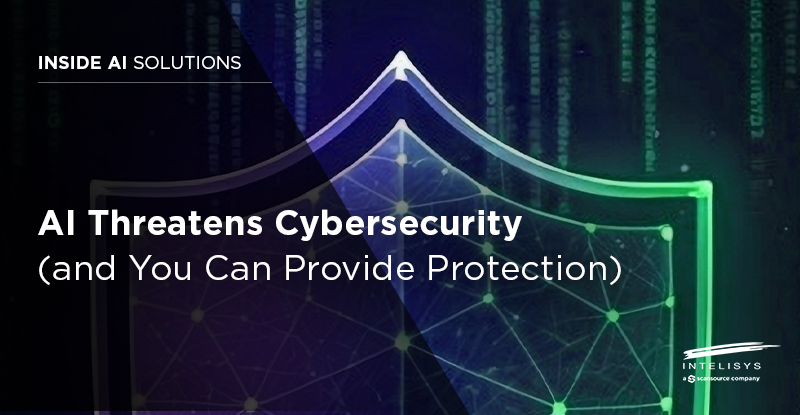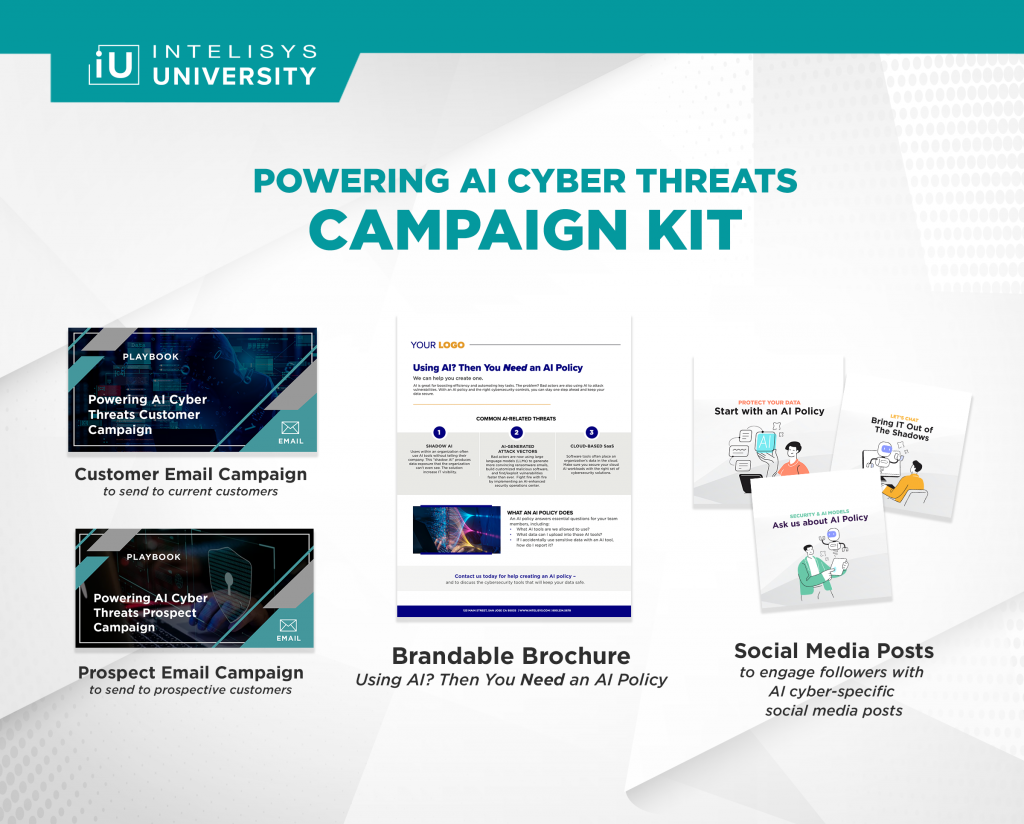
Everyone’s talking about AI these days – and for good reason. It can increase efficiency, improve customer experience (CX), and even support decision-making. In simple terms, it helps get things done.
But there’s a problem: AI is also increasing cyber threats. When users leverage AI, they often expose data and cause data leakage. Additionally, bad actors can use AI themselves to find and attack new vulnerabilities with frightening precision.
The solution here isn’t for organizations to stop using AI. The technology is too beneficial for that – and businesses that opt out are sure to lag behind.
The goal is to use AI safely – which organizations can do by:
- Adopting an AI policy
- Implementing data security solutions
As an Intelisys Sales Partner, you’re perfectly placed to help your clients with these strategies.
The rise of AI (and the cyber threats it’s producing) will provide you with countless opportunities. Below, we’ll tell you how to take advantage of them.
How AI Is Powering Cybersecurity Threats
The widespread use of generative AI is still a relatively new phenomenon – and whenever such a major shift occurs in the tech world, little cracks (aka “vulnerabilities”) are bound to appear.
Before organizations can start protecting themselves against AI-related cyber threats, they need to understand where vulnerabilities arise. Here are 2 problem areas to consider.
Shadow AI
AI is proliferating quickly – so quickly that employees often want to start using new tools before the organization has formally implemented them into its workflows. At first glance, there doesn’t seem to be anything wrong with this. Why shouldn’t users leverage the best tools available to improve their work performance?
The problem is that, while using these tools, team members might expose sensitive data. And the organization’s IT team – including cybersecurity experts – will have no idea of what’s going on. That means vulnerabilities go unaddressed – often until it’s too late.
Organizations need to eliminate this “shadow AI” use by increasing their endpoint visibility – allowing IT leaders to know exactly which AI solutions employees are using for work-related tasks.
AI-Generated Attack Vectors
Unfortunately, your customers aren’t the only ones who will benefit from AI’s enhanced efficiency. Threat actors can use it to become more efficient, too. The days of detecting ransomware emails through poor spelling and grammar are over. Armed with generative AI, threat actors are creating ransomware emails that are more accurate and much harder to detect.
The “bad guys” also use generative AI in malicious scanning tools, enabling them to find backdoors, mistakes in configuration, and technical loopholes in an organization’s cybersecurity controls. Worse, they can do all of this at speed. That’s why organizations should double down on security while leveraging AI.
Providing Protection to Your Clients
The most effective Sales Partners present themselves as trusted consultants, not just salespeople. You start by asking stakeholders what you can do for them – and then follow up with a mix of advice and potential IT solutions.
The “AI cyber threat” discussion seems tailor-made for this approach. As a consultant, you can guide organizations through the process of implementing an effective “AI Policy” – and then suggest solutions from the extensive Intelisys catalog that will help them keep their data secure.
Let’s explore those strategies a bit further.
Creating an AI Policy
An organization’s AI Policy provides users with the basic guidelines they need to use AI tools responsibly.
These policies can vary widely depending on the organization’s size and purpose – but they should all answer 3 key questions for users:
- What AI tools are we allowed to use?
- What data can I upload into those AI tools?
- If I accidentally upload sensitive data into an AI tool, how do I report it?
A decent AI policy will give the organization’s employees appropriate guidelines for the effective use of generative AI. It will also provide the organization with liability protection (since employees will have received adequate communication regarding the appropriate use of the technology).
As another benefit, the policy should directly reduce the use of “shadow AI” tools.
Offering Data Security Solutions
As organizations increase their use of AI tools, they may want to invest more in cybersecurity to protect their sensitive data.
Depending on an organization’s situation, you might want to offer the following data security and data privacy solutions:
- Visibility-enhancing products. These tools allow IT managers and CIOs to monitor all the endpoints on their network – which helps prevent the use of “shadow AI.”
- Role-based access controls. When only users in certain positions can access some aspects of an organization’s AI infrastructure, it makes it less likely that sensitive data will be accidentally shared.
- Cloud data security products. Tools like Cloud Workload Protection Platforms (CWPPs) offer firewall protection while detecting intrusions.
- Data Loss Prevention (DLP) tools. These solutions detect when sensitive data is being used in unapproved platforms, and can even prevent unauthorized use in real time.
- AI Powered Security Operations Center (SOC). These tools allow you to “fight fire with fire” – leveraging AI to automate threat detection and incident response.
Talk to the Intelisys Sales Engineering team to learn more about these solutions.
Spotting AI-Related Cybersecurity Opportunities
In many cases, organizations don’t understand exactly what solutions they need. They just know that they want to leverage AI to enhance their operations, and they want to do it safely.
Here are some phrases to listen for when talking with stakeholders:
- “We are interested in AI, but we are concerned about securing it.”
- “We have users using AI tools, and we don’t know how they’re using them.”
When you hear these types of concerns, it’s time to mention the importance of an AI policy and the potential for implementing data security solutions.
Starting the “AI Cybersecurity” Conversation
Even if organizations don’t raise AI-related security concerns themselves, they’re likely to benefit from local LLMs and other AI solutions – and they’ll need help with data security as they transition to AI-assisted workflows. You’ll just have to take the lead in steering the discussion.
Here are some questions to ask that will kickstart the conversation:
- What’s your strategy for securing AI?
- Do you have an AI policy?
- What business use case do you think AI could solve for your business?
Remember, it’s okay to keep these questions open ended. You don’t need to go straight for “the sale.”
Also, try to keep the conversations relatively narrow in scope. Some stakeholders might have unrealistic expectations, thinking AI will immediately transform or automate every aspect of their business operations. Encourage them to focus first on single use cases where they’ll be able to see a clear ROI.
Learn More About AI and Cybersecurity
To expand your knowledge of AI solutions (and how your clients can use them safely), check out the resources available at Intelisys University.
Relevant materials include:
- Several new AI courses (created in the past few months)
- A cybersecurity video series (with James Morrison, Sr. Director of Security Solutions)
And don’t hesitate to contact the Intelisys Solutions Engineering team for guidance. They’re here to answer your questions – and to help you capitalize on the opportunities that the AI revolution is providing
Also, check out our AI-cybersecurity campaign kit– a package of marketing materials you can deliver with your own branding!


